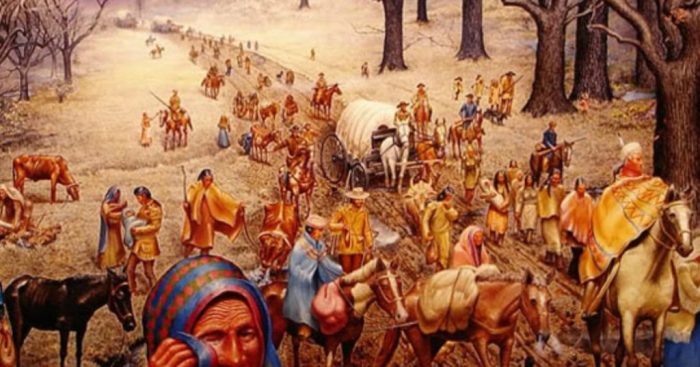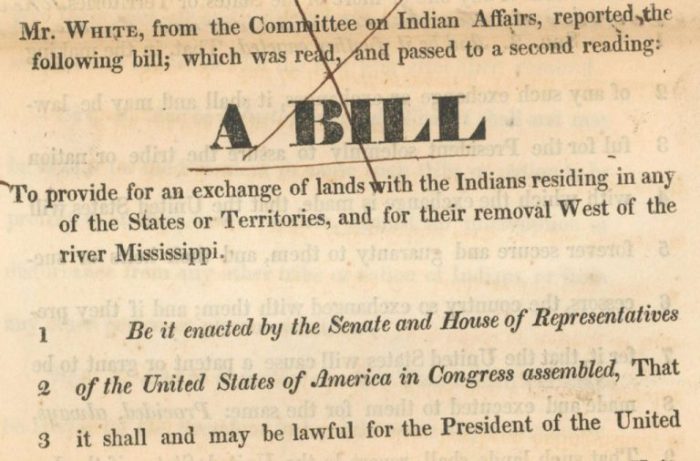Democracy sovereignty and the struggle over cherokee removal – Democracy, Sovereignty, and the Struggle over Cherokee Removal examines the complex interplay between democratic principles, tribal sovereignty, and the forced relocation of the Cherokee Nation in the 19th century United States. This in-depth analysis sheds light on the historical context, legal challenges, and lasting impact of this pivotal event.
The Cherokee Nation, with its established government and cultural identity, faced significant challenges to its sovereignty. The Indian Removal Act of 1830 sought to forcibly relocate Native American tribes, including the Cherokee, to lands west of the Mississippi River. This act sparked a fierce resistance from the Cherokee, who employed political and legal strategies to defend their rights.
Historical Context of Cherokee Sovereignty
The Cherokee Nation, one of the most prominent Native American tribes in the southeastern United States, established a sophisticated government and cultural identity over centuries. Their sovereignty was recognized through treaties and agreements with the United States government, such as the Treaty of Hopewell (1785) and the Treaty of New Echota (1835).
The Cherokee government, led by a principal chief and a national council, exercised authority over a defined territory, maintained a judicial system, and regulated trade and commerce. They developed a written language, a system of education, and a vibrant cultural heritage.
However, the legal basis for Cherokee sovereignty faced challenges from the United States government, which asserted its authority over Native American tribes based on the doctrine of discovery and the concept of “Indian country” as dependent territories.
The Indian Removal Act and Its Impact

The Indian Removal Act of 1830 authorized the federal government to negotiate treaties with Native American tribes to exchange their lands in the East for lands west of the Mississippi River. The act aimed to extinguish Native American claims to lands desired by white settlers and facilitate the expansion of the United States.
Arguments in favor of removal included the belief in the superiority of white civilization and the inevitability of Native American assimilation. Opponents argued that removal was unjust, violated treaties, and would disrupt the lives and cultures of Native American tribes.
The Cherokee resisted removal, but under pressure from the government and settlers, they were forced to relocate to Indian Territory (present-day Oklahoma) in the 1830s. The Trail of Tears, as the forced relocation became known, resulted in the deaths of thousands of Cherokee and had devastating effects on their society and culture.
The Role of Democracy in the Cherokee Struggle

The Cherokee Nation’s resistance to removal was guided by democratic principles and values. Cherokee leaders, such as John Ross, advocated for their rights through political and legal strategies.
Ross and other Cherokee leaders argued that the Cherokee were a sovereign nation with the right to self-government and that the Indian Removal Act violated their treaties and constitutional rights. They petitioned the government, appealed to the courts, and sought support from sympathetic white allies.
The Cherokee also organized protests and demonstrations to voice their opposition to removal. Their efforts raised awareness of their plight and helped to galvanize support for their cause.
The Legacy of Cherokee Removal

The Cherokee removal had a lasting impact on the tribe and the United States. The forced relocation disrupted their way of life, caused the loss of lives and land, and undermined their sovereignty.
The removal set a precedent for the forced relocation of other Native American tribes and established the principle of federal authority over Native American affairs. It also raised questions about the rights of Native Americans and the obligations of the United States government.
In recent years, there have been efforts to address the historical injustices committed against the Cherokee and other Native American tribes. These efforts include the establishment of tribal sovereignty, the return of lands, and the recognition of cultural rights.
Expert Answers: Democracy Sovereignty And The Struggle Over Cherokee Removal
What was the significance of the Indian Removal Act?
The Indian Removal Act of 1830 authorized the federal government to negotiate treaties with Native American tribes for the exchange of their lands east of the Mississippi River for lands in the west.
How did the Cherokee resist removal?
The Cherokee resisted removal through political and legal means. They petitioned the government, filed lawsuits, and appealed to the international community.
What was the Trail of Tears?
The Trail of Tears refers to the forced relocation of approximately 16,000 Cherokee people from their ancestral lands in the southeastern United States to Indian Territory (present-day Oklahoma) in the 1830s.